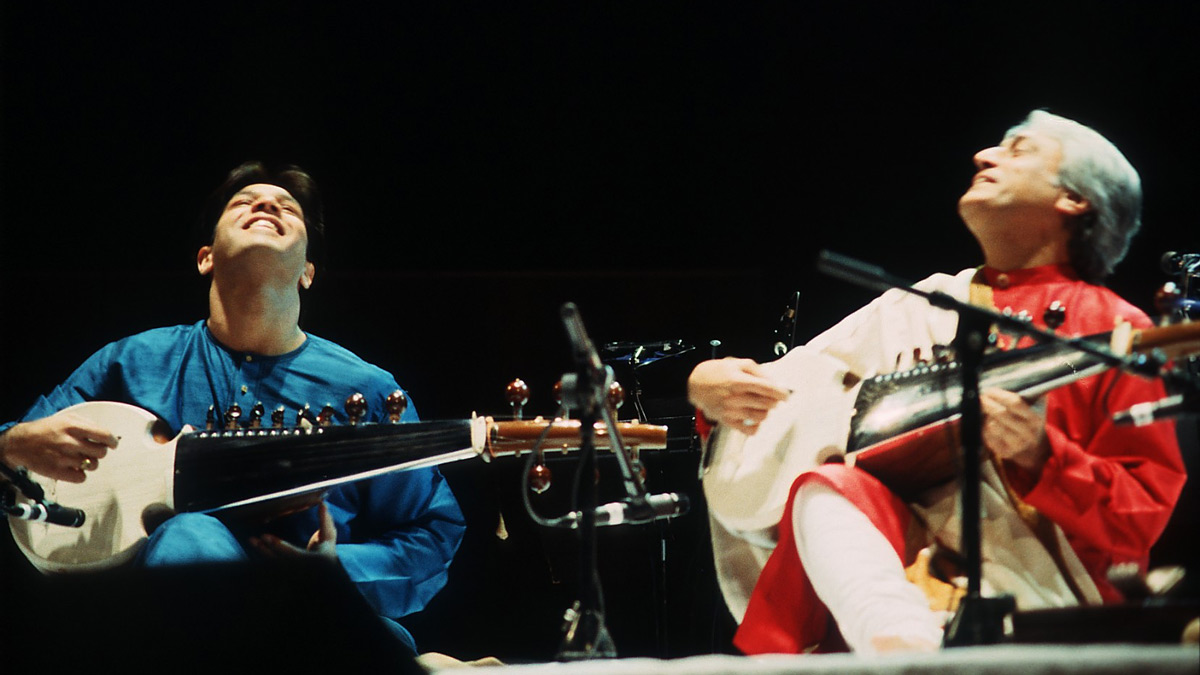How to integrate Indian music techniques in your guitar playing
Master the basics of Alankar melodic ornamentation
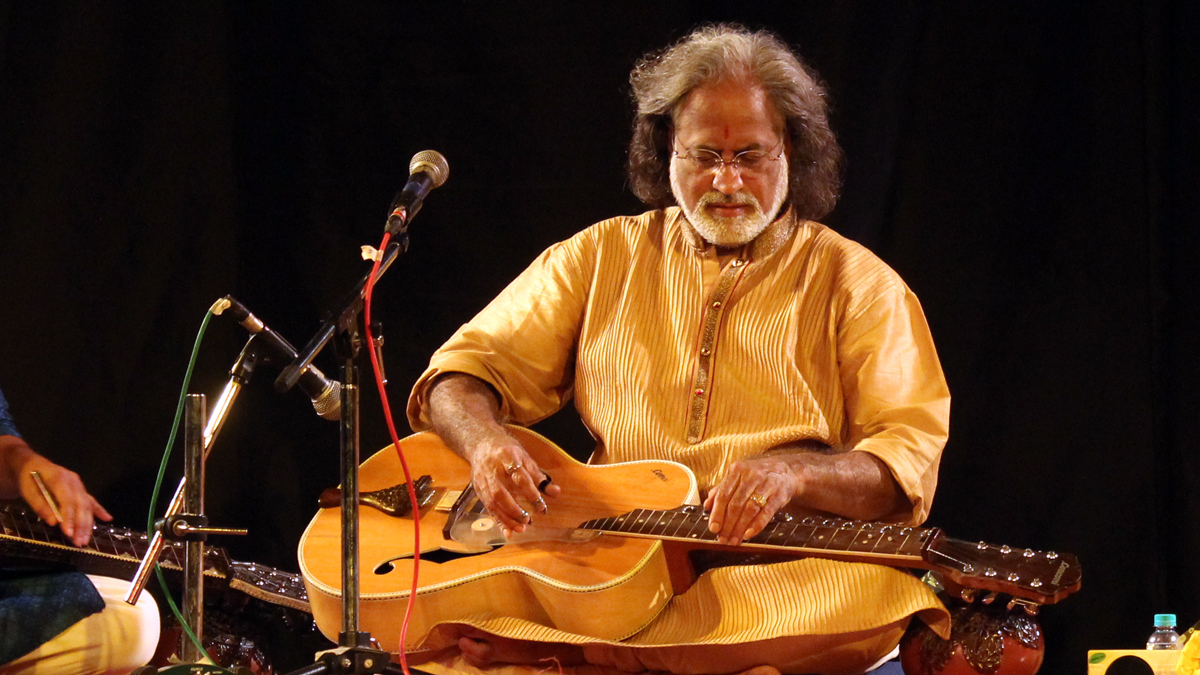
Indian classical music has a distinctive ‘singing’ melodic feel. Unique bends, slides, vibratos, and legatos capture the expressive flexibility of the voice, and then extend it far beyond what can be humanly sung. Hindustani ornamentations are collectively referred to as ‘alankar’.
Listen to the clip below for some outstanding alankar in motion. This lesson will translate some of these ideas to the guitar, so you can switch on an ‘Indian feel’ in your melodic playing - applicable to jazz, rock, funk, and further afield.
No prior knowledge is required, although Lesson 1's Rāga Basics gives a quick introduction to Hindustani music if you’re interested.
In order, you’re listening to: bansuri, santoor, sitar, vichitra veena, santoor, voice, and sarangi
What exactly is alankar?
Alankar is an ancient Sanskrit word, referring to any pattern of ‘musical decoration’. Hindustani music is primarily about single-line melodic development, without much in the way of chord progressions or functional harmony. This focus on melody gives decorative elements a particular importance - hear how the ornamentations squeeze more from each phrase in the clip.
The easiest way to hear the difference alankar can make is to look at a simple melody, then ‘alankarize’ it. Listen to this ‘Indianised’ version of Baa Baa Black Sheep (no, seriously) - Gurmukh Singh showcases different regional styles of alankar (‘wooooooollllll....’).. Pick out the distinctive ornamentations - how do they give life to the phrases?
What is possible depends on the instrument - Hindustani violinists slide around the fretboard, sitar strings can bend upwards over half an octave, and the holes of a bansuri flute can be partially covered. The strings of a santoor (hammered dulcimer) cannot be slid or bent - instead, the player brushes across adjacent strings in quick succession, giving the illusion of ‘spaces between the notes’.
Get the MusicRadar Newsletter
Want all the hottest music and gear news, reviews, deals, features and more, direct to your inbox? Sign up here.
There are countless ways to look at alankar, with different gharanas (regional teaching styles) having different approaches. Śārṅgadeva, a legendary 13th century scholar, created an elaborate system with 63 distinct alankar (and things have moved on in the past seven centuries). Common categories include meend (glides - e.g. bending) and gamaka (heavy oscillations - e.g. vibrato). We need not be concerned with exact classifications for now, but bear in mind there’s a lot of nuance here.
We’ll be mimicking some Hindustani alankar in the examples below, using bends, slides, vibrato, and hammer/pulls. They can be a challenge for the ear at first, with intricate shapes that Westerners aren’t accustomed to hearing in fine detail. But we can learn to ‘zoom in’ pretty quickly. And we’re looking to learn from Hindustani music rather than exactly imitate it here - the guitar has its own strengths, and we should bring them out.
Example 1 - Sliding in Raag Kalavati
Kalavati is a playful and flirtatious rāga, meaning ‘well versed in the arts’. It approximates to 1-3-5-6-b7-8, like a Mixolydian mode with no 2 or 4. The b7 is often played weakly in aroha (ascent), and the emphasised vadi & samvadi (king & queen notes) are 5 and 1 respectively. Melodic phrases often start on 3, and the forbidden (varjit) 4 gives extra prominence to the 5.
Notice that the first three notes form a major triad, giving a strong shape to build from. Faster and more intricate playing tends to feature the higher register notes. See it this way - the lower half of the scale (1-3-5) is made of wide jumps (4 then 3 semitones), while notes at the top (5-6-b7-8) are closely clustered (2, 1, then 2 semitones). Bringing out the contrast between the two halves of the scale is crucial, and sliding can help us do this.
The exercise below is in two parts. First, a ‘no-frills’ melody in Kalavati, to internalise the movement and harmonic feel. Second, an alankar-style version of the same melody, showing how sliding can summon more from the same set of notes. Practice it slowly at first, focusing on emphasis. Really zoom in on your timing - there’s a lot of space to play with in the long slides, and you can ‘stretch and compress’ the emphasis of alankar phrasings. Try the Hindustani of putting talcum powder on your fingertips (seriously, you won’t look back).
n.b. It’s pretty clear that Western notation isn’t built to handle intricate alankar. The tabs are accurate (thanks to Guitar Pro’s help guide...), but not always easily readable. Listen carefully to the demos - Hindustani music is traditionally unwritten and learned by ear, and the fine detail only comes out this way.
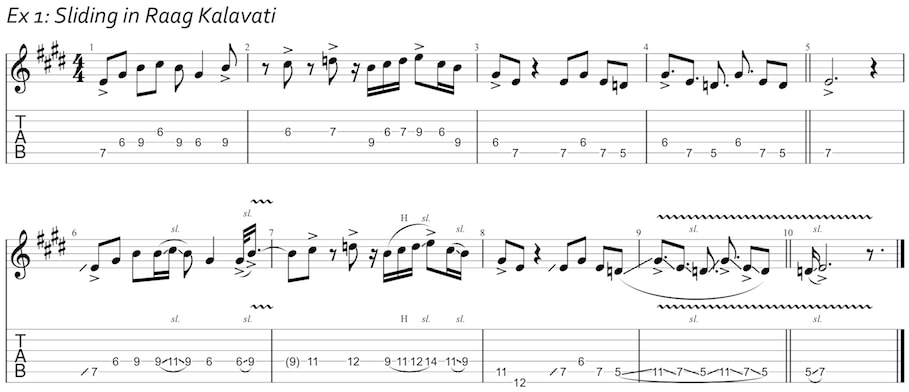
As ever, use this as a starting point. How else could you slide around using Kalavati’s ideas?
- 1-3-5-6-b7-8 - Mixolydian with no 2 or 4 (dominant 13th harmony)
- 5 and 1 as strong notes, 3 as common starting tone, weak b7 on ascent
- Tetrachord-style scale contrast: wide major triad (lower) and clustered scale (upper)
Example 2 - Bending in Raag Bhairavi
Bhairavi, the ‘queen of rāgas’, is often played at sunrise, or as the final piece in a concert. It is named after the Hindu goddess of destruction, and melodically approximates to the Western Phrygian mode (1-b2-b3-4-5-b6-b7).
It can take a versatile Mishra (‘mixed’) form as Sindhu Bhairavi: all 12 notes are allowed, injecting some rarely-heard chromaticism into Hindustani music. To some it can evoke ‘awe, terror, and destruction’; to others ‘a pleasant sobering atmosphere full of love and piety’. It’s an important rāga, which we’ll cover in more detail in future lessons.
This example again ‘alankarizes’ a melody in Bhairavi, by using sustained bends on the A and E strings. It requires finger strength - build slowly, and don’t overstrain yourselves (tendonitis is no fun). Practice each bend in isolation, then combine them. You may want to change your wrist from a ‘grip’ to a ‘classical’ position at the start of bar 3.
Try quickly pushing up to the highest point of the final bend, and then releasing more gradually, emphasising the contrast with the previous bar’s take on the same note (India’s final bar rhythmic resolutions are a fascinating topic in their own right.) Start slow!
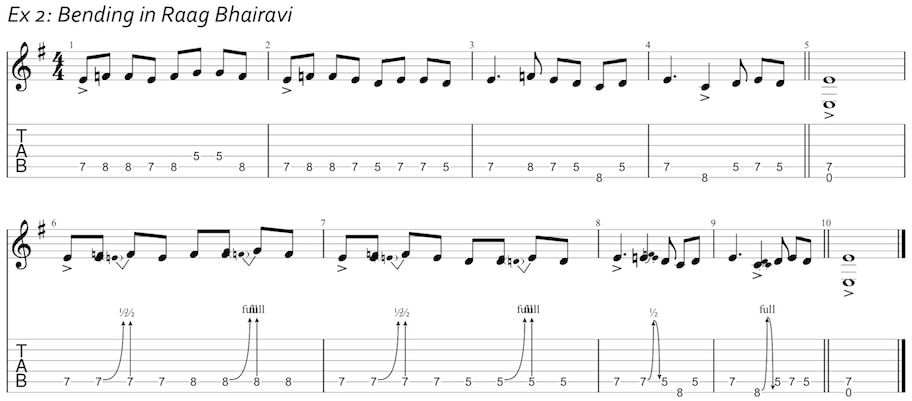
When you can play each bend one way, go through and find new ways to approach them. Try looping the first two bars for a versatile Hindustani groove, and then running the pattern through Bhairavi’s ideas:
- 1-b2-b3-4-5-b6-b7 - approximates to Phrygian mode
- 1 and 4 as strong notes, can take Mishra form (all 12 notes allowed)
- Can use some chromaticism - versatile shapes and moods
Example 3 - Mixed Alankar in Raag Bageshri
We now revisit Bageshri, introduced in Lesson 1: Rāga Basics. Bageshri approximates to the Dorian mode, and aims to evoke the profound longing of waiting for a lover to return. 1 and 4 are strong notes, 5 is played weakly or omitted, and 2 and 6 are often heavily ornamented.
This exercise brings out of Bageshri’s characteristic tensions using several approaches to alankar: vibrato, sustained bends, rapid slides, and hammer/pulls. There’s a lot to take in at first, and the unfamiliar alankar shapes can feel like speed bumps. Again, learn each one individually before combining them, and consciously move away from your ‘default vibrato’.
In the final bar, hit the first note hard (it’s the highest pitch in the melody), and make it contrast with the upcoming open string tone. And as you go, try and see the fundamental ‘shapes’ of each alankar - i.e. what would the pattern sound like if you looped it and moved up through the scale? Listen to the demo carefully.
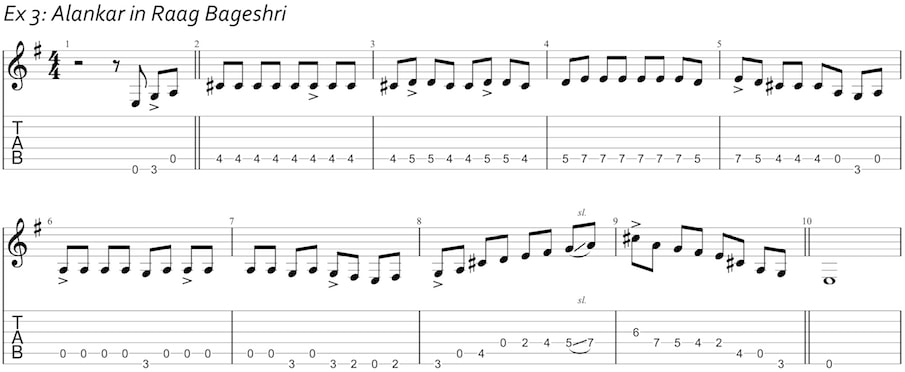
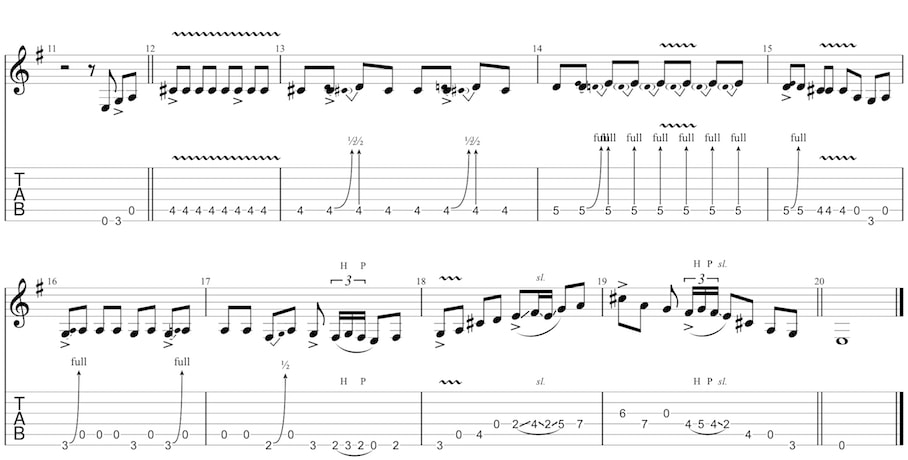
Try combining this with ideas from the Bageshri study in Lesson 1 - a recap:
- Dorian mode with emphasised 1, 2, 4, and 6
- Weak or absent 5, spacious ‘4-6 jump’
- Heavy alankar on 2 and 6
Expanding your sound: physical considerations
Hindustani music is a living tradition. The availability of microphones has influenced how modern musicians play, allowing whispering sitar bends to fill a concert hall. New instruments are regularly designed and borrowed from other cultures.
They’re almost all built with gayaki ang (singing style) in mind, allowing for new and distinctive alankar. New inventions have enriched the guitar world - the Mohan veena is a modified lap-slide with 20 strings, which has in turn inspired similar creations (chaturangi, Hansaveena, and Shankar veena to name a few). The fluid piano adds string sliders, allowing you to play ‘between the keys’.
What physical limits do guitarists come up against?
The guitar is an unusually versatile instrument. But we always feel as if we’re pushing against certain physical boundaries - something brought into clearer focus by attempting alankar. So how can we get beyond these limits?
- Talcum powder. Sticky fingertips are a nightmare for any instrumentalist, making it easy to stumble in intricate playing. Hindustani musicians often put talcum powder on their fingertips to overcome this. I cannot recommend this enough - sliding becomes effortless, and the fretboard shrinks in front of your eyes.
- Down-tuning. Few guitars can bend upwards more than 2 or 3 semitones. But the lower string tension of sitars allows them to far surpass this limit, reaching huge bends of more than 7 semitones. I often tune my electric down a tone, and my acoustic down two tones (to D and C respectively), allowing for sweeping bends - now recording demos in standard tuning feels strange and constricting. Also, a lot of Hindustani music is rooted in the C-D range, meaning you can play along.
- Strengthening your hands. Swimming, pull-ups, and light weight training quickly build hand power and endurance - a tip I picked up from mountain climbing friends. Many already do this - classical violin virtuoso Maxim Vengerov regularly hits the gym, in order to ‘maintain his physicality with the instrument’. Stretch carefully beforehand, and don’t overstrain yourself.
How else can we expand the guitar’s sound with Indian ideas?
Master fusioneer John McLaughlin has devoted much of his career to answering this question. After leaving the Miles Davis electric group, his style became rich with Hindustani melodies and Carnatic South Indian rhythms. In his all-acoustic Shakti group, he plays alongside violin, tabla, mridangam, and ghatam clay pot, and wields a modified steel string with scalloped frets and sympathetic strings, conjuring up new vibratos and timbres.
Listen to McLaughlin’s searing 7-beat solo on Lady L, where he uses various Indian ideas to push the limits of the acoustic guitar. He flies around the Dorian mode with astonishing precision, using the scalloped frets to ornament heavily, while always keeping the logic of his phrasing intact.
Again, we’ve only scratched the surface of alankar. Listen to more Hindustani music (suggestions below), and let your ear ‘zoom in’ on the weird and wonderful ornamentations. Take the idea further in your playing - downtune, use the whammy bar, pick up a slide, etc. Choose your alankar shapes consciously, and practice the best ones until they’re automatic.
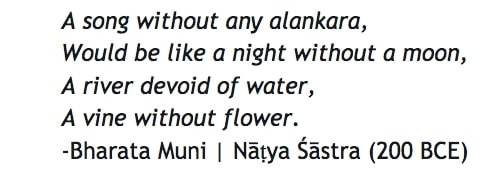
George Howlett | www.ragajunglism.org
Suggested listening
- NPR Tiny Desk - Debashish, Subhasish, and Anandi Bhattacharya - vocal, tabla, and chaturangi slide guitar trio performance, overflowing with divine alankar [15 mins]
- Raag Jog - Kushal Das - the low string tension of the surbahar (bass sitar) allows for sweeping bends [19 mins]
- Suddha Dhanyasi: Carnatic sliding lesson - South Indian Carnatic music has its own world of ornamentation. Let Mandolin Prakash get you started on the guitar [14 mins]
